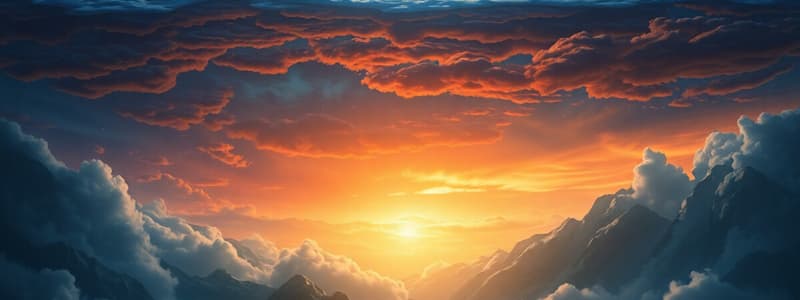Podcast
Questions and Answers
What percentage of Baguio City's water supply comes from groundwater?
What percentage of Baguio City's water supply comes from groundwater?
- 85% (correct)
- 90%
- 75%
- 95%
Which of the following is NOT a property of rainwater?
Which of the following is NOT a property of rainwater?
- Contains dissolved gases
- Contains particulate matter
- Is completely pure (correct)
- Can have bacteria
How do ions in seawater primarily differ from river water?
How do ions in seawater primarily differ from river water?
- River water has higher salinity than seawater.
- River water has a higher concentration of chloride.
- Seawater contains 0.012% dissolved salts.
- Seawater contains about 3.5% dissolved salts. (correct)
What is the primary function of an aquifer?
What is the primary function of an aquifer?
What is the main environmental concern associated with gold mine tailings?
What is the main environmental concern associated with gold mine tailings?
Which layer is characterized by a rapid decrease in temperature with depth?
Which layer is characterized by a rapid decrease in temperature with depth?
What effect can dam construction have on aquatic life?
What effect can dam construction have on aquatic life?
Which mineral primarily comprises seawater's dissolved ions?
Which mineral primarily comprises seawater's dissolved ions?
When water weathers rocks, what fundamental change occurs?
When water weathers rocks, what fundamental change occurs?
What is the atmospheric turnover time for precipitation according to the provided information?
What is the atmospheric turnover time for precipitation according to the provided information?
What process involves the breakdown of organic matter, releasing carbon into the soil?
What process involves the breakdown of organic matter, releasing carbon into the soil?
What is the primary source of carbon that forms fossil fuels like coal and oil?
What is the primary source of carbon that forms fossil fuels like coal and oil?
In the water cycle, what occurs immediately after evaporation of water?
In the water cycle, what occurs immediately after evaporation of water?
What percentage of Earth's surface is covered by water?
What percentage of Earth's surface is covered by water?
What role did volcanic activity play in the formation of early Earth's hydrosphere?
What role did volcanic activity play in the formation of early Earth's hydrosphere?
Which phase in the water cycle involves plants releasing water vapor into the atmosphere?
Which phase in the water cycle involves plants releasing water vapor into the atmosphere?
What process describes the falling of water droplets from clouds back to Earth?
What process describes the falling of water droplets from clouds back to Earth?
Where does the majority of Earth's water reside?
Where does the majority of Earth's water reside?
The condensation of water vapor in the atmosphere leads directly to which component of the water cycle?
The condensation of water vapor in the atmosphere leads directly to which component of the water cycle?
What primarily contributes to the release of CO2 back into the atmosphere?
What primarily contributes to the release of CO2 back into the atmosphere?
Which gas was NOT a major component of the early atmosphere?
Which gas was NOT a major component of the early atmosphere?
What primarily causes the decrease in temperature in the troposphere with increasing altitude?
What primarily causes the decrease in temperature in the troposphere with increasing altitude?
Which layer of the atmosphere contains the majority of the ozone?
Which layer of the atmosphere contains the majority of the ozone?
What is the Karman line commonly associated with?
What is the Karman line commonly associated with?
Which gas is responsible for varying concentrations in the atmosphere along with humidity?
Which gas is responsible for varying concentrations in the atmosphere along with humidity?
What primarily contributes to atmospheric phenomena like clouds and rain?
What primarily contributes to atmospheric phenomena like clouds and rain?
At what altitude does the mesosphere extend up to?
At what altitude does the mesosphere extend up to?
Which of the following layers exhibits an increase in temperature with altitude?
Which of the following layers exhibits an increase in temperature with altitude?
What is the primary role of aerosols in the atmosphere?
What is the primary role of aerosols in the atmosphere?
Which of the following statements about humidity is true?
Which of the following statements about humidity is true?
What primarily causes the temperature increase in the upper atmosphere?
What primarily causes the temperature increase in the upper atmosphere?
Which of the following is NOT a main function of the atmosphere?
Which of the following is NOT a main function of the atmosphere?
What causes the variation in seasons on Earth?
What causes the variation in seasons on Earth?
Which process describes how Earth's atmosphere retains heat?
Which process describes how Earth's atmosphere retains heat?
During which months does Baguio City experience a wet season?
During which months does Baguio City experience a wet season?
Which component is primarily recycled through the carbon cycle?
Which component is primarily recycled through the carbon cycle?
What is the role of photosynthesis in the carbon cycle?
What is the role of photosynthesis in the carbon cycle?
How does the greenhouse effect influence Earth's surface temperature?
How does the greenhouse effect influence Earth's surface temperature?
What accounts for the high levels of annual precipitation in Baguio City?
What accounts for the high levels of annual precipitation in Baguio City?
Which gas is not a component of Earth's atmosphere?
Which gas is not a component of Earth's atmosphere?
Flashcards
What is the atmosphere?
What is the atmosphere?
The gaseous layer surrounding Earth, composed of a mixture of gases known as air.
What was the early atmosphere composed of?
What was the early atmosphere composed of?
The original atmosphere was primarily methane, ammonia, water vapor, and neon, with significantly more carbon dioxide than today.
How did the atmosphere become oxygenated?
How did the atmosphere become oxygenated?
Unicellular organisms played a crucial role in introducing oxygen into the atmosphere through photosynthesis.
What are the permanent gases in the atmosphere?
What are the permanent gases in the atmosphere?
Signup and view all the flashcards
What are some variable gases in the atmosphere?
What are some variable gases in the atmosphere?
Signup and view all the flashcards
What is humidity?
What is humidity?
Signup and view all the flashcards
What are aerosols?
What are aerosols?
Signup and view all the flashcards
What is the troposphere?
What is the troposphere?
Signup and view all the flashcards
What is the Karman line?
What is the Karman line?
Signup and view all the flashcards
What is the thermosphere?
What is the thermosphere?
Signup and view all the flashcards
Thermocline
Thermocline
Signup and view all the flashcards
Halocline
Halocline
Signup and view all the flashcards
Pycnocline
Pycnocline
Signup and view all the flashcards
Salinity
Salinity
Signup and view all the flashcards
Aquifer
Aquifer
Signup and view all the flashcards
Water weathering
Water weathering
Signup and view all the flashcards
Mine tailings
Mine tailings
Signup and view all the flashcards
Kaliwa Dam
Kaliwa Dam
Signup and view all the flashcards
Groundwater flow
Groundwater flow
Signup and view all the flashcards
Dissolved salts
Dissolved salts
Signup and view all the flashcards
Decomposers
Decomposers
Signup and view all the flashcards
Fossil Fuel Formation
Fossil Fuel Formation
Signup and view all the flashcards
Fossil Fuel Combustion
Fossil Fuel Combustion
Signup and view all the flashcards
CO2 Absorption by Plants
CO2 Absorption by Plants
Signup and view all the flashcards
Hydrosphere
Hydrosphere
Signup and view all the flashcards
Evaporation
Evaporation
Signup and view all the flashcards
Transpiration
Transpiration
Signup and view all the flashcards
Condensation
Condensation
Signup and view all the flashcards
Precipitation
Precipitation
Signup and view all the flashcards
Snowmelt Runoff
Snowmelt Runoff
Signup and view all the flashcards
What are the main functions of the atmosphere?
What are the main functions of the atmosphere?
Signup and view all the flashcards
What is the Greenhouse Effect?
What is the Greenhouse Effect?
Signup and view all the flashcards
Why do seasons exist?
Why do seasons exist?
Signup and view all the flashcards
What happens during photosynthesis?
What happens during photosynthesis?
Signup and view all the flashcards
What happens during respiration?
What happens during respiration?
Signup and view all the flashcards
How does Carbon fixation by consumers work?
How does Carbon fixation by consumers work?
Signup and view all the flashcards
What is the Carbon Cycle?
What is the Carbon Cycle?
Signup and view all the flashcards
Describe the climate of Baguio City.
Describe the climate of Baguio City.
Signup and view all the flashcards
Study Notes
Atmosphere
- The atmosphere is a gaseous layer surrounding Earth.
- Air, the mixture of gases in the atmosphere, is primarily composed of nitrogen (78%) and oxygen (21%).
- Water vapor and aerosols are key components influencing atmospheric phenomena.
- Atmospheric composition varies with altitude, becoming less dense as altitude increases.
- Early Earth's atmosphere was primarily methane, ammonia, water vapor, and neon, with significantly higher carbon dioxide content.
- Unicellular organisms played a role in providing oxygen to the atmosphere.
Atmosphere's Composition
- Permanent Gases: Nitrogen (N2), Oxygen (O2), Argon (Ar)
- Variable Gases: Water vapor (H2O), Carbon dioxide (CO2), Methane (CH4), Ozone (O3), and other trace gases
- These variable gases have varying concentrations dependent on location and time.
Layers of the Atmosphere
- The atmosphere is divided into layers based on temperature gradients. These include the troposphere, stratosphere, mesosphere, thermosphere, and exosphere.
- Troposphere: Lowest layer; Contains most weather phenomena; Temperature decreases with altitude.
- Stratosphere: Contains much of the atmosphere's ozone; Temperature increases with altitude.
- Mesosphere: Temperature decreases with altitude.
- Thermosphere: Temperature increases with altitude due to absorbing solar radiation.
- Exosphere: Outermost layer, where atmosphere merges with space
Humidity
- Air contains water vapor, and humidity varies geographically and is affected by temperature.
- Air also contains solid particles, which influence atmospheric phenomena.
Greenhouse Effect
- The greenhouse effect is a natural process that traps heat in Earth's atmosphere.
- Gases in the atmosphere absorb and re-emit infrared radiation, warming the planet.
- The process is essential for maintaining a habitable temperature on Earth. Without this effect, the Earth would be significantly colder.
Hydrosphere
- The hydrosphere encompasses all water on Earth's surface, underground, and in the atmosphere.
- Water on Earth formed around the same time as the atmosphere.
- During the late heavy bombardment period, water arrived on Earth via chemical reactions, meteorites, or comets.
- Volcanic activity released water vapor in the early Earth.
Distribution of Water on Earth
- About 71% of Earth's surface is covered by water
- Oceans hold around 96.5% of all the water on Earth.
Water Cycle
- The water cycle describe the continuous processes (evaporation, transpiration, condensation, precipitation, runoff) by which water moves between the Earth's surface and atmosphere.
Groundwater
- Groundwater is water located beneath the Earth's surface.
- Fills pores and fractures in rock; Important to water supply
River and Ocean Water
- Salinity refers to the dissolved salt content of water.
- Seawater contains about 3.5% dissolved salts; River water contains much less salt.
Water Properties and Composition
- Water in rivers and lakes contains dissolved minerals and salts from surrounding rocks.
- Water temperature influences the amount of minerals it can dissolve.
- Mine tailings can affect water quality due to pollution from the mining process.
Water-Rock Interactions
- Water can change the composition of rocks through weathering processes.
- Water's mobility helps elements be transferred from place to another.
- Groundwater is often affected by mining and construction.
Studying That Suits You
Use AI to generate personalized quizzes and flashcards to suit your learning preferences.




